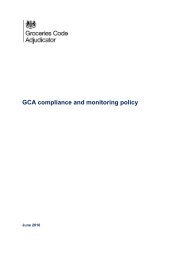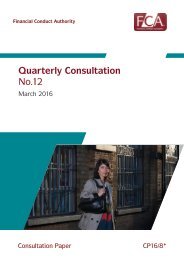You also want an ePaper? Increase the reach of your titles
YUMPU automatically turns print PDFs into web optimized ePapers that Google loves.
36 <strong>BHS</strong><br />
<strong>BHS</strong> would also have to find £5 million to contribute to the pension fund, which had<br />
previously been financed by the wider Taveta group.<br />
107. The Taveta board was presented, two weeks after the event, with a rosy picture of<br />
the sale: the pension scheme was secure and <strong>BHS</strong>, unencumbered by substantial debt,<br />
was left with a healthy “day one” balance sheet of £94 million. The reality was very<br />
different. The balance sheet included cash for immediate liabilities, property deals<br />
that took many months to materialise, funds that went to RAL never to return and<br />
equity that was a loan on punitive terms. It was patently obvious that there was simply<br />
not enough cash in <strong>BHS</strong> to give it a realistic chance of medium term survival.<br />
Proceeding with an unsuitable buyer<br />
108. Sir Philip Green initially appears to have set three conditions for RAL to meet to<br />
demonstrate their credibility as a prospective buyer of <strong>BHS</strong>. However, ultimately he sold<br />
the company to Dominic Chappell without any of these having been met:<br />
Table 3: Conditions for sale of <strong>BHS</strong> set by Sir Philip Green 238,239,240241242243<br />
Initial condition of sale<br />
Position when sale completed<br />
That they inject their own equity in to the RAL provided no equity to the deal. £5<br />
company. 238 million came via a loan from ACE secured<br />
against a property owned by <strong>BHS</strong>. Further<br />
equity was subsequently provided by Sir<br />
Philip Green in lieu of the funds from the<br />
planned sale of Marylebone House. 239<br />
That they provide a credible retail ‘frontman’.<br />
240<br />
That they have sufficient working-capital<br />
to keep the business afloat on an ongoing<br />
basis. 242<br />
RAL had no credible retail front-man. On<br />
10 March, prior to Taveta approving the<br />
sale, Ian Grabiner telephoned Kevin Lyon<br />
(who RAL had proposed as non-executive<br />
Chairman), who confirmed that he was not<br />
interested in the role. 241<br />
RAL failed to meet the terms of borrowing<br />
£120m from Farallon; the only workingcapital<br />
available to RAL was provided or<br />
arranged by Sir Philip Green. 243<br />
109. In order to progress the sale of <strong>BHS</strong>, Sir Philip Green endorsed a management<br />
turnaround plan that he claimed should have saved the company; 244 he also agreed to write<br />
off the majority of the inter-company debt between <strong>BHS</strong> and Arcadia, while retaining a<br />
£40 million secured loan and guaranteeing a £25 million facility with <strong>BHS</strong>. Sir Philip also<br />
made oral commitments to back the <strong>BHS</strong> pension scheme. He told us:<br />
“We always agreed and knew we would make a contribution towards the<br />
pension scheme. When the business was sold that was always understood.” 245<br />
238 Email from Paul Budge to Dominic Chappell, 15 December 2014<br />
239 Letter from Michael Hitchcock, 12 June 2016<br />
240 Email from Paul Budge to Dominic Chappell, 15 December 2014<br />
241 Letter from Kevin Lyon, 13 June 2016.<br />
242 Email from Paul Budge to Anthony Gutman, 3 December 2014<br />
243 See paragraphs 90 to 104, above.<br />
244 Q 2046: “If the path laid down had been followed, [<strong>BHS</strong>] would not have gone out of business. It would not be in<br />
liquidation.”<br />
245 Q 1919






